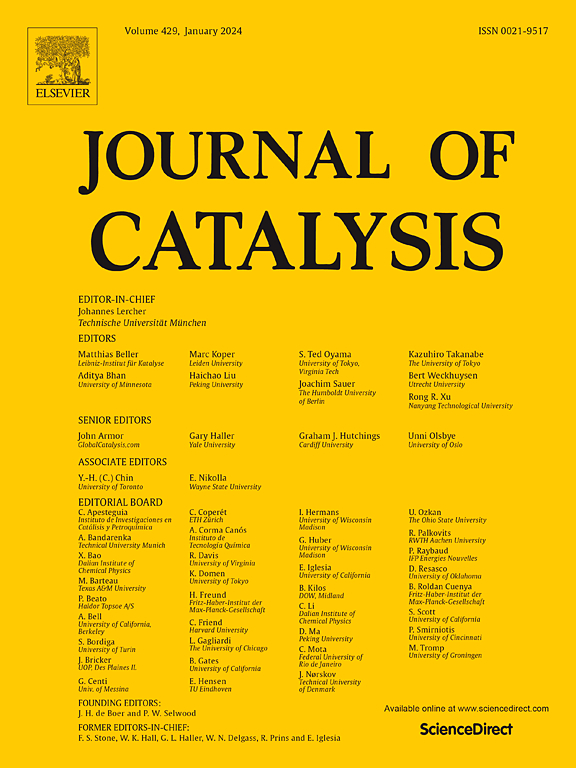基于ni基层次化纳米片催化剂的生物质衍生芳香族n杂环化合物电化学合成
IF 6.5
1区 化学
Q2 CHEMISTRY, PHYSICAL
引用次数: 0
摘要
生物质的电化学增值为芳香族n杂环是一个前沿领域,也是一种环保的合成策略。本文以KI为电解质和介质,采用镍基电催化剂,开发了生物质呋喃与1,2-苯二胺的电氧化环缩合反应,以97 ~ 80 %的产率合成喹啉类化合物(16个例子)。电催化剂被开发成ni纳米片,密集地组装在编织碳布上,具有层层叠叠的3d开放网络。呋喃-喹啉的电化学转化包括ni促进的I−到-[I+]电氧化、[I+]诱导的呋喃-到呋喃氧化和呋喃/1,2-苯二胺环缩合的串联反应。Ni催化剂的高性能是由于其对I−到-[I+]的快速选择性电氧化有促进作用,从而引发[I+]介导的呋喃氧化。相反,1,2-苯二胺直接氧化的竞争反应在阳极镍表面被明显抑制。因此,本研究为生物基化合物电催化转化制备高附加值芳香族n杂环化合物提供了一条可持续发展的途径。本文章由计算机程序翻译,如有差异,请以英文原文为准。

Electrochemical synthesis of biomass-derived aromatic N-heterocycles by using Ni-based hierarchical nanosheets catalysts
Electrochemical valorization of biomass to aromatic N-heterocycles is a pioneering field and an eco-friendly synthetic strategy. Herein, electro-oxidative cyclocondensations of biomass-based furoin with 1,2-phenylenediamines are developed for quinoxalines syntheses (16 examples) in 97∼80% yields by using Ni-based electro catalyst with KI as electrolyte and mediator. The electrocatalyst is developed as Ni-nanosheets densely assembled on a knitted carbon cloth with a hierarchical 3D-open network. The electrochemical furoin-to-quinoxaline transformation involves a tandem reaction of Ni-promoted I−-to-[I+] electro-oxidation, [I+]-induced furoin-to-furil oxidation, and furil/1,2-phenylenediamine cyclocondensation. The high performance of Ni catalyst is ascribed to its promotion effect on quick and selective I−-to-[I+] electro-oxidation, thus triggering a [I+]-mediated furoin oxidation. In contrast, the competitive reaction of direct 1,2-phenylenediamine oxidation is significantly suppressed on the anodic Ni surface. This research thus highlights a sustainable way for the productions of high value-added aromatic N-heterocycles by electro catalytic transformation of biomass-based compounds with earth-abundant transition-metal catalyst.
求助全文
通过发布文献求助,成功后即可免费获取论文全文。
去求助
来源期刊

Journal of Catalysis
工程技术-工程:化工
CiteScore
12.30
自引率
5.50%
发文量
447
审稿时长
31 days
期刊介绍:
The Journal of Catalysis publishes scholarly articles on both heterogeneous and homogeneous catalysis, covering a wide range of chemical transformations. These include various types of catalysis, such as those mediated by photons, plasmons, and electrons. The focus of the studies is to understand the relationship between catalytic function and the underlying chemical properties of surfaces and metal complexes.
The articles in the journal offer innovative concepts and explore the synthesis and kinetics of inorganic solids and homogeneous complexes. Furthermore, they discuss spectroscopic techniques for characterizing catalysts, investigate the interaction of probes and reacting species with catalysts, and employ theoretical methods.
The research presented in the journal should have direct relevance to the field of catalytic processes, addressing either fundamental aspects or applications of catalysis.
 求助内容:
求助内容: 应助结果提醒方式:
应助结果提醒方式:


